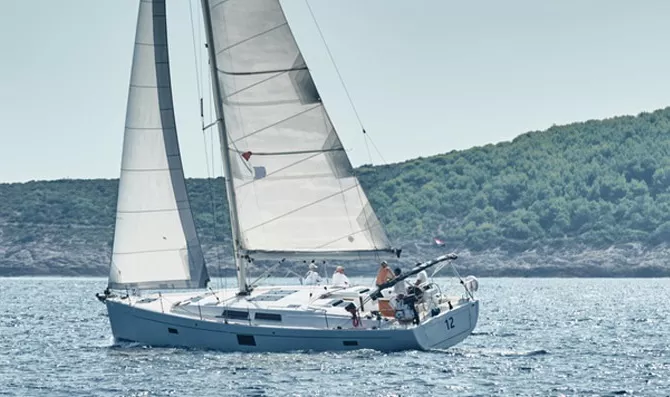Sailing yachts are vessels propelled primarily by sails, harnessing wind power to navigate the waters. They have evolved from simple boats to sophisticated crafts, serving various purposes from leisurely cruising to competitive racing. This article delves into the definition, types, purposes, and design considerations of sailing yachts, providing a clear and detailed understanding for both novices and enthusiasts.
What is a Sailing Yacht?
A sailing yacht is a recreational boat or ship designed to be propelled by sails. Typically, these yachts are equipped with a cabin for overnight accommodations, distinguishing them from smaller sailboats that may lack such facilities. While there is no universally accepted definition, a vessel is often considered a yacht if it meets certain criteria, such as being at least 33 feet in length and possessing aesthetic appeal. The term “yacht” originates from the Dutch word “jacht,” meaning “hunt,” referring to light, fast vessels used by the Dutch navy in the 16th and 17th centuries.
Types of Sailing Yachts
Sailing yachts can be categorized based on several factors, including hull design, stability mechanisms, rigging, and intended use.
Hull Design
Monohull Yachts:
These yachts have a single hull and are the traditional design for sailing vessels. They are known for their classic appearance and are further divided into:
- Centerboard Yachts: Equipped with a retractable centerboard, these yachts can adjust their draft, making them suitable for shallow waters.
- Keelboats: Featuring a fixed keel, often with added ballast, keelboats offer enhanced stability and are less prone to capsizing.
Multihull Yachts:
These include catamarans (two hulls) and trimarans (three hulls). Multihulls are generally faster and offer greater stability up to a certain heel angle. However, once this angle is exceeded, the risk of capsizing increases, and the consequences can be severe.
Stability Mechanisms
- Ballast Keels: Found in keelboats, ballast keels lower the center of gravity, enhancing stability and reducing the likelihood of capsizing.
- Centerboards: These are retractable fins that can be raised or lowered, allowing for adaptability in different sailing conditions and water depths.
Rigging
The configuration of a yacht’s sails and masts significantly influences its performance and handling:
- Bermuda Sloop: A common rigging type featuring a single mast with a mainsail and a headsail (jib), offering a balance between simplicity and efficiency.
- Catboat: Characterized by a single mast and a single sail, catboats are particularly popular among single-handed sailors due to their straightforward handling.
Purposes of Sailing Yachts
Sailing yachts serve various purposes, each tailored to specific activities and preferences:
- Racing Yachts: Designed for competitive sailing, these yachts prioritize speed and agility. They are built with lightweight materials and optimized hull shapes to maximize performance. Racing yachts often participate in events like the America’s Cup, a prestigious competition with a rich history dating back to 1851.
- Cruising Yachts: Intended for leisurely voyages, cruising yachts emphasize comfort and livability. They are equipped with amenities such as sleeping quarters, kitchens, and bathrooms, making them suitable for extended trips. Cruising yachts vary in size, with smaller ones designed for coastal waters and larger ones capable of ocean passages.
- Racer-Cruisers: These yachts blend features of racing and cruising vessels, offering a compromise between speed and comfort. They are suitable for sailors who wish to participate in races while also enjoying comfortable cruising capabilities.
Design Considerations
Designing a sailing yacht involves balancing various factors to meet specific performance and comfort requirements:
- Seaworthiness: The yacht’s ability to withstand different sea conditions, ensuring the safety and comfort of its occupants.
- Performance: Influenced by factors such as hull shape, sail area, and weight distribution, performance design focuses on speed and handling characteristics.
- Comfort: For cruising yachts, interior layout and amenities are designed to provide a pleasant living experience during voyages.
- Cost of Construction: Budget constraints influence material choices, design complexity, and overall yacht size.
Modern Innovations
Advancements in materials and technology have led to significant innovations in yacht design:
- Multihull Designs: Catamarans and trimarans offer increased stability and space, appealing to both racers and cruisers. Companies like Sunreef have gained recognition for their luxury multihull yachts, combining performance with opulence.
- Luxury Features: Modern yachts often incorporate high-end amenities, such as spacious lounges, gourmet kitchens, and advanced entertainment systems, enhancing the cruising experience. The Ritz-Carlton Yacht Collection, for example, offers luxury yachts like Ilma, providing exceptional comfort and service without the typical cruise elements.
Conclusion
Sailing yachts are versatile vessels that combine the art of sailing with the comforts of modern living. Whether for racing, cruising, or a blend of both, they offer unique experiences on the water. Understanding the different types, purposes, and design considerations can help enthusiasts make informed decisions and fully appreciate the rich heritage and ongoing innovations in yacht design.

